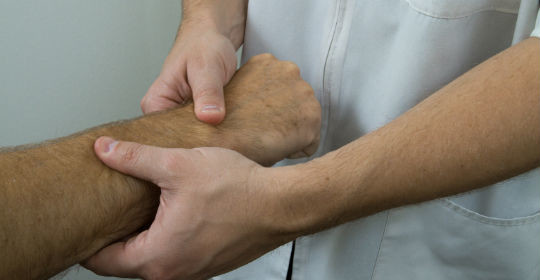
10 Simple Tips To Ease Joint Pain
Any arthritis sufferer will tell you that joint pain is no joke. Swollen, painful joints can hamper every aspect of day to day living and movement can be substantially reduced as well as being painful. Irrespective of the initial cause – be it through either of the more commonly known types of arthritis such as Osteoarthritis or Rheumatoid arthritis, joint pain can get steadily worse if left unchecked and there are certain things that can be done to ease the affliction.
As restriction through inflammation continues, the stiffness and lack of flexibility can continue to grow worse. Arthritis itself might not be life threatening but it can become totally life-changing and sometimes the worst of the condition’s side-effects could be prevented by taking very simple steps.
In addition to the pain, it’s often the degradation of quality of life that is the most cause for concern. Daily tasks that previously seemed easy may well become more difficult and frustrating as time progresses, movements such as bending, twisting and kneeling can easily become restricted and sometimes too difficult to do.
Living with joint pain means taking a pro-active approach to self-help and to start living in an intuitive and holistic way so that healing works with the body naturally.
Often current daily processes can irritate and damage the joints so taking a good look at how you live your life is a good starting point. Whilst there is a great deal that can be done to ease the pain and the suffering experienced, the most important aspect of taking care of your joints is to halt progressive degeneration of the joint itself and this means adapting any of the tips listed here to suit your own personal situation.
10 Simple Tips to Ease Joint Pain
1. Yoga
There are many different styles of yoga to choose from but hatha yoga which focuses on the physical aspects of the yoga postures is a great starting point. Because joint pain can cause a great many limitations in terms of movement, it can be a great relief for arthritis sufferers to know that yoga really is non-competitive and therefore, even if attending a class, the focus has to be on the individual itself and their own progress.
Gentle stretching that helps to relieve tension from the muscles, increases circulation in the joints and helps to remove toxins and any other waste products. Each extreme position (as far as the person can go comfortably) should be held for a few seconds but this can gradually be increased as the body relaxes into the posture through regular practice. The key to success with yoga is to practice a little each day and do this in accordance for when the body feels more prepared for the stretches. If experiencing extreme pain then it pays to rest the joints for a while until the pain eases a little.
2. Massage
Massage to co-inside with the yoga practice or undertaken separately is extremely beneficial for swollen or painful joints. Always ensure that a good massage oil is used but fancy preparations are not necessary. A warm solution of olive oil massaged gently into the joint can be warming and soothing but a massage with castor oil is also highly beneficial and can ease discomfort and increase flexibility. Done before the yoga session or any other exercise plan will help to increase the stretch, and to assist the movement in the joint throughout.
Massage can help arthritis sufferers in two main ways. It helps to reduce muscle pain and tension within the muscles often caused by the spasms of pain experienced. Secondly, it increases the production of endorphins and can reduce feelings of anxiety and depression often associated with the long –term battle with stiff and painful joints.
3. Meditation
Meditation can help to promote and increase the healing process by relaxing the body whilst promoting natural healing. Meditation is very easy to master and the benefits far outweigh the potential difficulties associated with stilling the mind in the first instance. A healing meditation can soothe body, mind and soul, ease anxieties, lessen the negative aspects of depression, and improve positivity, clarity and the power to self-heal.
Although meditation can be used in a variety of different formats, focussing on vivid imagery in the mind’s eye can be very successful. The colour blue has long been associated with healing and it can help to visualize yourself completely immersed in a beautiful blue of light or bathing in a pool of regenerative liquid that soothes and heals.
Practiced regularly, meditation becomes an easy but powerful tool in the fight against arthritis.
4. Weight-Loss
If overweight, it’s important to streamline your frame and to take the pressure of any extra weight from the joints. Your back, hips, knees and ankle joints have to take a considerable amount of pressure each and every day. Walking, bending, and lifting, all place significant amounts of stress on any inflamed joints so it’s essential to watch calorie and fat intake and to reduce any number of sweet treats. Losing a bit of weight will aid pain control and will automatically enable you to improve flexibility.
If you find yourself snacking and at risk of breaking your new healthy eating regime, keep ready- prepared fruit and veggies in the fridge and this will help you to stay on the straight and narrow.
It can be a good idea to reduce the amount of larger meals consumed each day, instead, dish up some smaller meals as it has been confirmed that nibbling healthier and smaller meals helps to boost your metabolism therefore helping to reduce weight the easy way and yet still easing the pressure off of your joints. By losing under a stone in weight, you could literally cut your chances of developing osteoarthritis by up to 50%.
5. Food and Exercise Diary
A food and exercise diary can really help to consolidate the message of healthy eating for healthy joints as opposed to the somewhat negative thought process that can often accompany a new dietary regime. Irrespective of how much you would like to lose to ease the pressure from your joints, the goal is to improve overall health in addition.
Writing down how you feel each day in your food and exercise diary (including your emotions and deepest frustrations) can really afford you that extra bit of clarity when it comes to dealing with your arthritic condition and it can also highlight any common patterns or themes associated with the joint pain. Sometimes certain foods can trigger a nasty bout of pain and swelling, by keeping a diary, these foods will be easier to isolate.
6. Footwear
Wearing sensible shoes will help to take the strain of the body’s weight whilst providing an excellent support for the feet and ankles. High heels for example can increase the chances of developing osteoarthritis whilst putting considerable extra pressure on the knee joints, ankles and ball of the foot and it alters correct posture in addition.
7. Strong Bones
Strong bones are essential and you can ensure that your bones are fit and healthy by boosting your intake of calcium. Osteoporosis –most commonly known as the brittle bone disease, needs calcium to ensure that your bone density is robust. Calcium is easy to obtain through supplements or through simply eating food such as: salmon, broccoli, figs, milk and kale. Lettuces, spinach, parsley or broccoli can also lessen the amount of bone loss that occurs as you get older.
8. Vitamins
Soak up your vitamins by making sure that you eat and drink healthily. Vitamin C in the form of a lovely glass of orange juice can reduce the risk of osteoarthritis and Vitamin C also helps to repair the tissues and general joint heath supported by Vitamin K.
Make sure that your diet is colourful so that you get the full range of fibre and antioxidants (great for fighting disease). Glucosamine has become increasingly popular in recent years and is obtained from lobsters, crabs and shrimps. It has been shown to ease stiffness and help to reduce joint pain; it has even been linked to repairing cartilage.
It is also well documented that eating fish such as mackerel can help to reduce any pain or inflammation of joint pain but it’s not always easy to eat sufficient amounts of omega-3’s, so supplement your diet with some fish oil capsules.
9. Posture
Watch your posture. Sitting slumped in front of a computer screen for hours on end can cause a great many problems for arthritis of the spine and commonly, stiffness in the neck and shoulder joints. If you have to work long hours in a mainly sedentary position, then it’s important to keep movement occurring within those key areas. Try to move away from your desk after 30 minutes or so and do some gentle stretching exercises by stretching your neck and doing shoulder lifts- any movement in fact that will increase circulation and flexibility in those areas.
Use document holders that can attach to your computer monitor, so that you do not need to keep looking down and straining your neck. Take office ergonomics very seriously and ensure that everything that is needed is to hand. To ensure that your PC is in the right position for you, stretch out your arm directly in front of you and you should be just unable to touch the monitor. Likewise, you should stare directly at the monitor and not be looking up or down.
Make a conscious effort to watch your posture throughout the day and you will soon be able to notice whether your posture is a potential cause or irritant for your joint pain.
10. Swimming
Take the plunge and go swimming. Swimming is a great exercise for anyone who suffers from joint pain. Non weight-bearing, it still strengthens your muscles and exercises the joints without placing too much pressure on any painful joint.
If you suffer from a great deal of pain and the joints are very inflamed, you will feel as if you need to restrict movement, this is a natural instinct however, light gentle movement will work to keep those joints oiled but care should be taken to avoid stress or actual injury.
Aquatic exercise routines are also wonderful to keep the body strong and supple with minimal strain.
Summary
Joint pain should be taken seriously.
Left unchecked with the cause of the pain undetermined and you are asking for the condition to degenerate. Painful, stiff joints may have you reaching for the pain-killers but remember that pain-killers only treat the symptoms and not the cause. Use as directed to assist quality of life but take the time to look at your lifestyle as a whole, and that means treating your diet and exercise regime as a way of a life and not as a necessary chore.
Flexibility is paramount and can help to prevent joint pain from occurring in the first instance or to aid healing, however, any exercises should be done carefully, with full focus on the movement and using the breath to help release any tension as movement takes place.
Little and often is recommended and is a positive and natural approach to joint pain.
Disclaimer: The content within the report is to guide and inform only. If you have any health concerns, it is important to seek medical advice.


Leave a reply